Physical Address
304 North Cardinal St.
Dorchester Center, MA 02124
Modic changes are subchondral and vertebral bone marrow changes in conjunction with intervertebral disc degeneration, and they are classified into three categories (types 1, 2, and 3) based on magnetic resonance imaging appearance.
Modic changes, especially Modic type 1 change, are associated with low back pain but they are also prevalent among people without low back pain.
The precise pathology of Modic changes is unclear but their development requires structural disc damage and inflammatory response to it. Bacterial etiology behind Modic changes is possible but lacks solid evidence.
To date, there are no definite guidelines on how to treat patients with low back pain and Modic changes.
Special thanks to Professor Frances Williams for helping to write the chapter and Anne Kukkonen for performing lumbar MRIs in the Northern Finland Birth Cohorts.
Subchondral vertebral bone marrow changes were first described by Assheuer et al. [ ] and de Roos et al. [ ] in 1987 to separate degenerative marrow change from tumor or infection. In 1988, Modic et al. [ ] classified subchondral bone marrow changes associated with disc degeneration into two categories (type 1 and type 2) using magnetic resonance imaging (MRI) appearance and histologic samples, and afterward a third type (type 3) was identified using MRI [ ]. Later, these changes have been named generally as Modic changes (MCs). In the literature, MCs are also called as vertebral bone marrow change, vertebral endplate signal change, or vertebral endplate degenerative change (see Chapter 1, Chapter 10 ). MCs are changes of subchondral vertebral bone marrow ascending from the endplate toward the center of the vertebral body, and there are often no visible changes seen in the endplate.
The classification of MCs is traditionally based on bone marrow signal intensity on T1- (T1w) and T2-weighted (T2w) MRI to type 1 (MC1), type 2 (MC2), and Modic type 3 change (MC3). Subsequently, other sequences, such as fat-suppressed fluid-sensitive MRI (STIR) sequences, have also been utilized [ ]. The relationship between the three Modic types is discussed later (see Manifestations and Natural History).
Modic changes were previously not considered as a specific low back pain (LBP)-related imaging phenotype but, along with an increased understanding of MCs, this view has changed—especially in the case of MC1 [ ]. However, contradictory findings have been published also in recent years [ , ]. Many phenotypes have been described for lumbar MCs ( Table 11.1 ). In this chapter, we will discuss pathophysiology, natural history, and management of MCs with specific reference to its clinical and imaging phenotypes ( Table 11.2 ).
| Phenotype | Description | Author/Reference |
|---|---|---|
| Type 1 change (MC1) | Hypointense on T1-weighted (T1w) images and hyperintense on T2-weighted (T2w) images | [ ] |
| Type 2 change (MC2) | Hyperintense on both T1w and T2w | |
| Type 3 change (MC3) | Hypointense on both T1w and T2w | |
| Mixed types 1 & 2 (MC1/2) | MC1 and MC2 at the same locus | [ , ] |
| Mixed types 2 & 3 (MC2/3) | MC2 and MC3 at the same locus | |
| Endplate localization | Anterior Middle Posterior Left Left-paracentral Central Right-paracentral Right |
[ ] |
| Intravertebral location | Central Anterior left Anterior right Posterior left Posterior right |
[ ] |
| Maximum height ∗ | No MC Endplate only <25% of vertebral body volume 25-50% of vertebral body volume >50% of vertebral body volume |
[ ] |
| Intravertebral volume | Normal Endplate only <25% of vertebral body volume 25-50% of vertebral body volume >50% of vertebral body volume |
[ ] |
| Endplate area | No MC <25% of the endplate area 25-50% of the endplate area >50% of the endplate area |
[ ] |
| Transverse size | No MC Small (MC in 2-3 slices 1 ) Moderate (MC in 4-5 slices 2 ) Large (MC in 6-8 slices 3 ) Very large (MC in ≥9 slices 4 ) |
[ ] |
| Anteroposterior (AP) Diameter |
Anterior Central Posterior Small: MC in one portion Moderate: MC in two portions Large: MC in all three portions |
[ ] |
| Maximum height ∗ | No MC Endplate only <25% of vertebral body volume 25-50% of vertebral body volume >50% of vertebral body volume |
[ ] |
| Intravertebral location | Anterior Midpoint Posterior Left lateral Right lateral |
[ ] |
| Horizontal size | Summary score from nine affected intravertebral locations: Anterior left Anterior midpoint Anterior right Midpoint left Midpoint Midpoint right Posterior left Posterior midpoint Posterior right |
[ ] |
| MC grading score | Grade A: <25% of vertebral body height Grade B: 25%-50% of vertebral body height Grade C: >50% of vertebral body height |
[ , ] |
| Shape contouring of MC | Quantitative size: Region of MC | [ ] |
| Bone marrow composition | Bone marrow edema and fatty marrow Fat fraction of MC area | [ ] |
| Diffusion-weighted imaging | Claw sign Apparent diffusion coefficient |
[ ] [ ] |
∗ Evaluated from the sagittal image in which MC had the largest extension into the vertebra
1 Corresponding <25% of the transverse diameter of the vertebral body
2 Corresponding <50% of the transverse diameter of the vertebral body
3 Corresponding <75% of the transverse diameter of the vertebral body
4 Corresponding >75% of the transverse diameter of the vertebral body
| Classifier | Subclassifier | Phenotype |
|---|---|---|
| Imaging (MRI) | Modic change (MC) | MC type |
| MC location | ||
| MC height | ||
| MC width | ||
| Disc | Disc height | |
| Disc signal intensity | ||
| Disc displacement | ||
| Endplate | Endplate defect | |
| Schmorl's node | ||
| Clinical | Low back pain | Inflammatory pain pattern (MC1) |
| Treatment | Nonoperative | Good/poor responder |
| Operative | Good/poor responder | |
| Outlook | Imaging | UTE a , [ , ] |
| Treatment | Antibiotics [ ]/bisphosphonate [ ] |
The development of MCs in conjunction with intervertebral disc degeneration has been recognized. Modic changes were even originally described adjacent to a degenerated disc [ ], and they have been suggested to be a reactive response to disc degeneration and endplate injury [ , ].
Although the true nature and pathogenesis of MCs are still uncertain, MCs share several etiological factors and phenotypic characteristics with bone marrow changes at other sites of the body. For instance, bone marrow edema in conjunction with other joints, primarily hip and knee joint, has similar phenotypic characteristics with MC1 in MRI [ ]. Bone marrow edema can be found in multiple health conditions including knee osteoarthritis, spondylarthritis, and chronic tendinitis [ , ]. Histologically, the site of both bone marrow edema and MC1 can contain vascularization, infiltration of lymphocytes, and/or fibrosis, and these conditions can cooccur [ ].
Histologically, bone marrow demonstrating MC1 contains disrupted and fissured endplate, vascularized fibrous granulation tissue, and high bone turnover; MC2 consists of fatty regeneration of the bone marrow and reduced bone formation, whereas bone marrow demonstrating MC3 comprises bone sclerosis [ , ].
Overall, MCs can be viewed as a specific phenotype within the realm of endplate changes (ECs). The distinctive feature of MCs is the formation of intravertebral marrow edema. Other causes of ECs include infection, trauma, and Schmorl's nodes [ ]. Previous spine injury, intervention, or systemic disease can cause injury or changes to the functional spine segment that can predispose or cause disc injury, ECs, and MCs. If available, such patient information should be included for both the MRI radiologist and the clinician ( Figs. 11.1–11.4 ) .
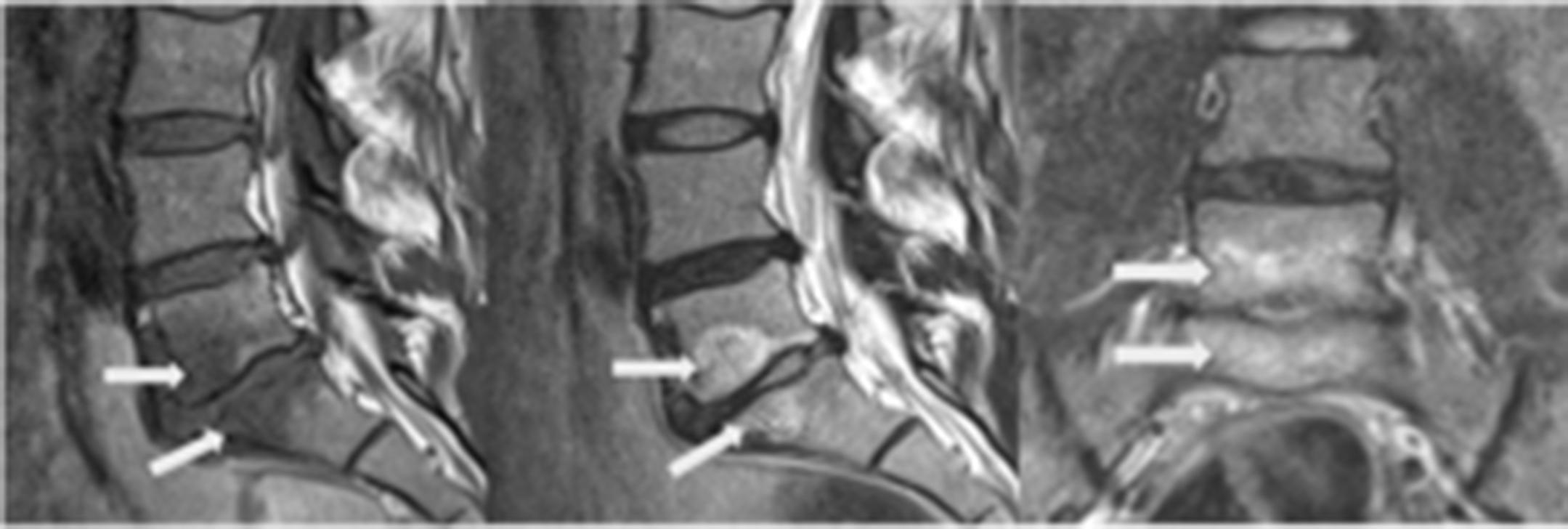
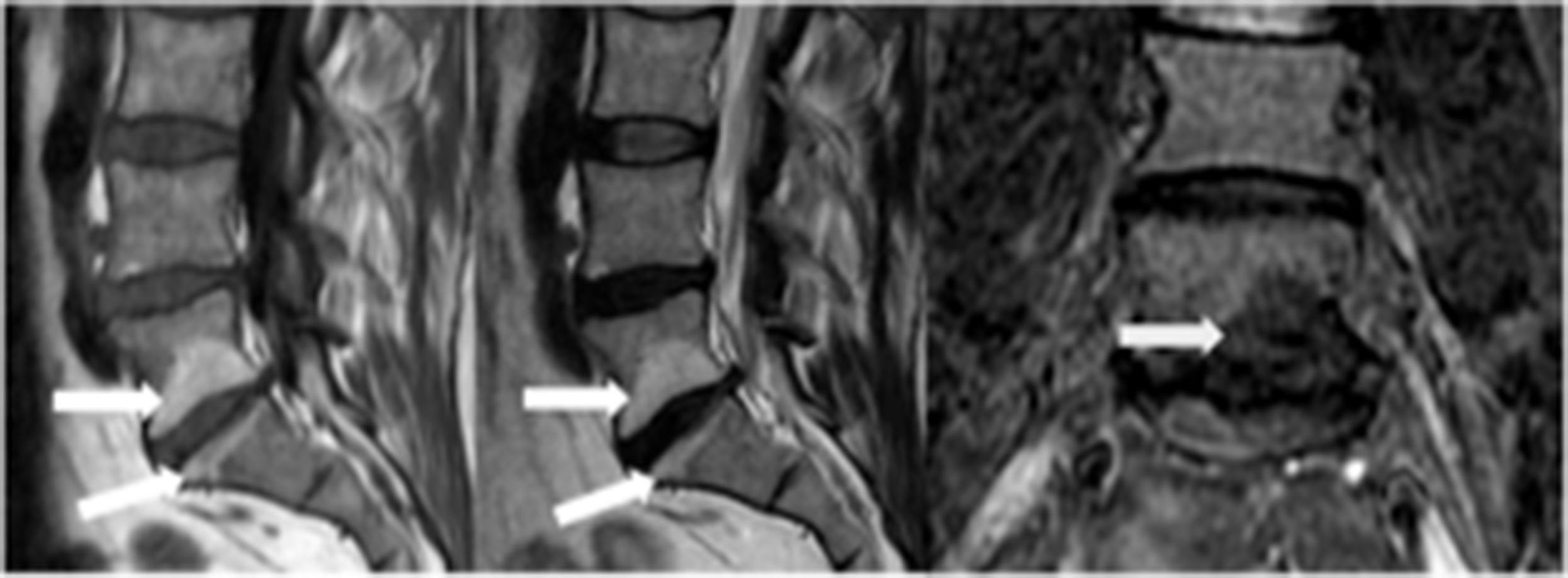
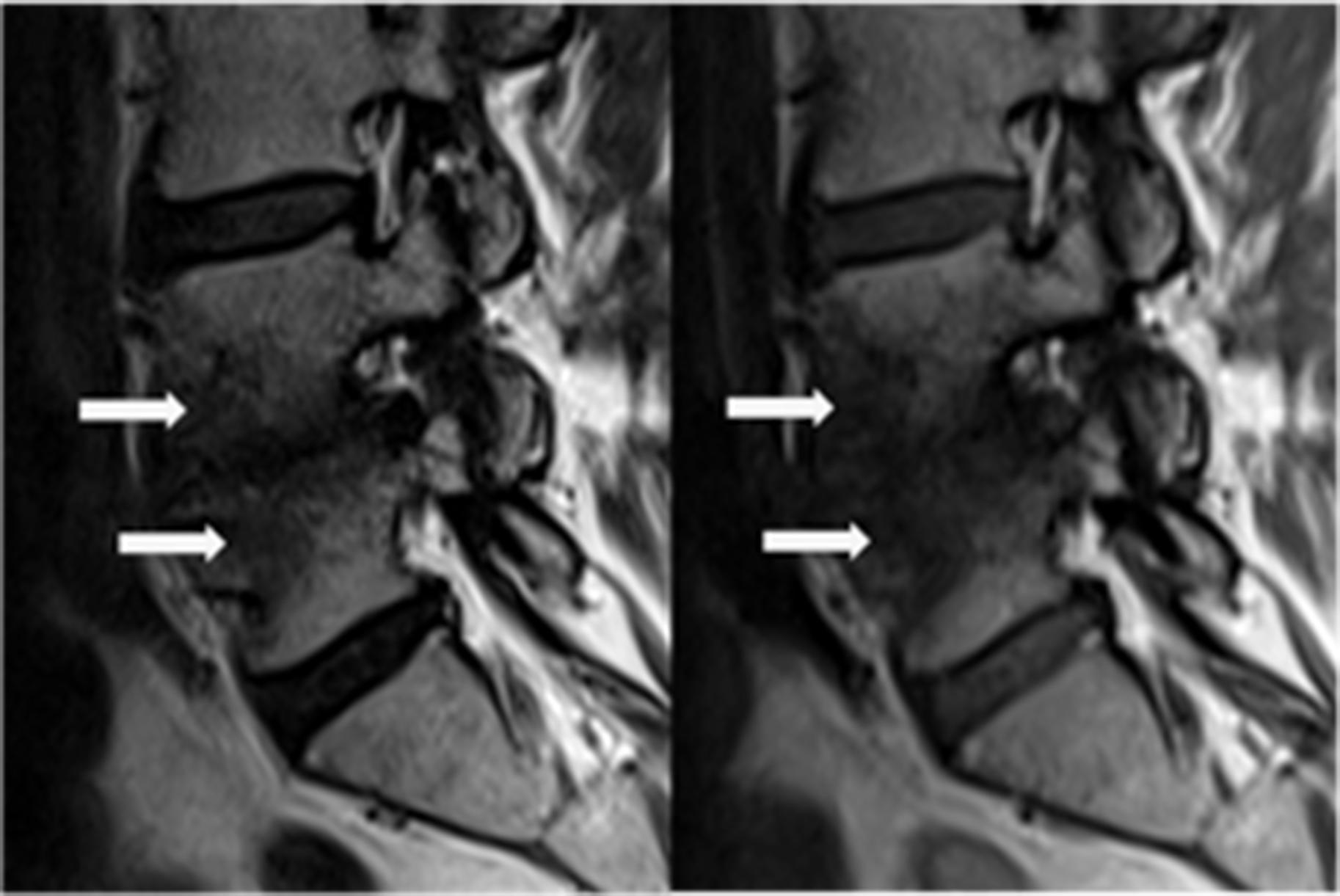
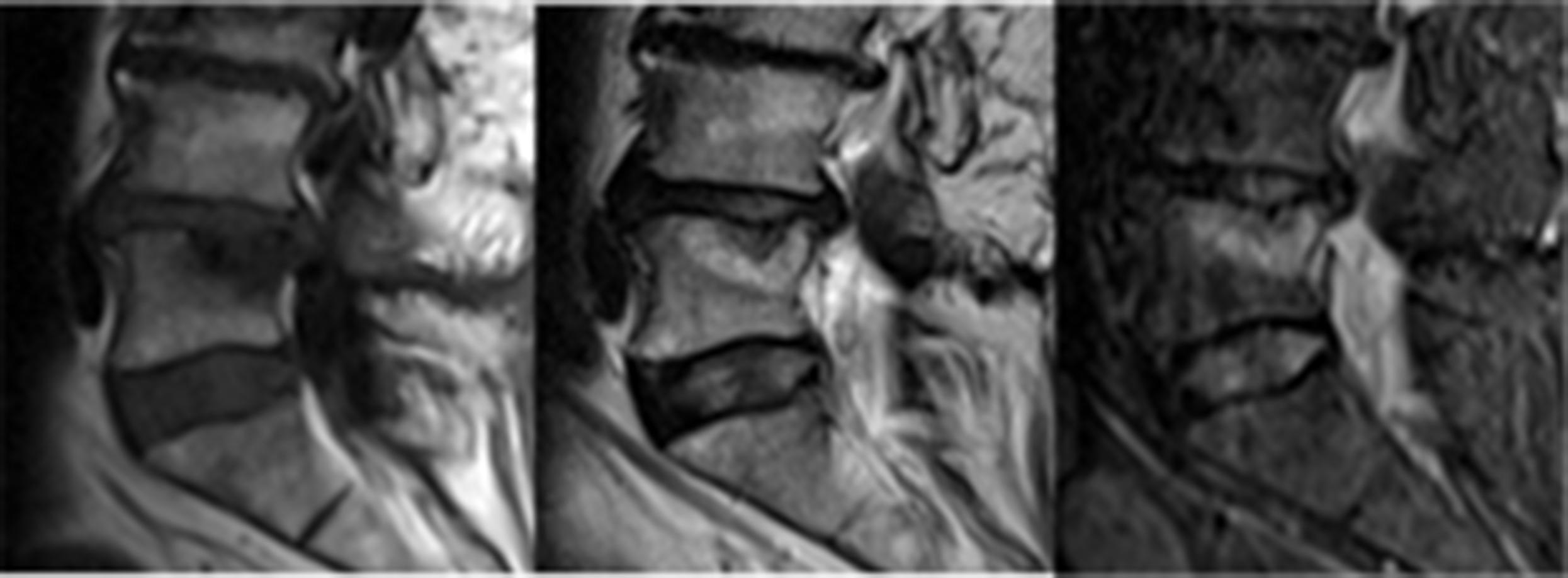
Research has demonstrated a close association between the genome and back pain [ ]. In the United Kingdom, twin study genetic heritability was found to be one of the major risk factors for reported episodes of severe LBP. Several gene variants have been linked with an increased genetic disposition to disc degeneration and LBP.
The association between gene variants and MCs has been investigated across studies. Karppinen et al. [ ] did in 2008 show that genetic variations in the interleukin-1A and matrix metalloproteinase-3 gene together were significantly associated with MC2. In 2019 a genome-wide meta-analysis identified a genetic locus on chromosome 9 associated with MCs [ ]. Rajasekaran et al. [ ] performed a proteomic analysis of intervertebral disc tissue to investigate the biological changes of MCs at the molecular level. They found 45 proteins specific for MC patients and in particular 14 host defense response proteins with altered pathways. Another study using proteomic analysis comparing endplate avulsion and MCs found significant alteration of nine proteins compared to patients without MCs [ ]. In 2022 a study by Vigeland et al. [ ] found that the expression of 37 genes was associated with STIR signal volume in patients with MC1. Gene sets related to interferon signaling, mitochondrial metabolism, and defense response to virus were significantly upregulated in all analyses. These results indicate that inflammation and immunological defense are important factors in MC biology in patients with LBP.
In summary, studies indicate that there is a genetic component to MC that includes altered signaling, metabolism, and host defense response.
Structural disc damage through endplate damage or disc herniation induces the development of MCs [ ], and MCs are rarely seen at structurally intact disc levels (see Chapter 1 ) [ , ]. When the endplate damages, the disc depressurizes, and this alters the mechanical environment of the intervertebral disc and causes progressive structural change to the motion segment [ ]. Endplate defects are associated with MC development fairly consistently across studies [ ]. Extracellular matrix changes have been observed in cartilage endplate with MCs as shown in a study investigating 40 patients with MCs and 20 patients without, where expression of a disintegrin-like and metalloprotease with thrombospondin motifs 5 (ADAMTS-5), catabolic enzyme, and tumor necrosis factor-α (TNF-α) was significantly upregulated in cartilage endplates of those having MCs [ ].
Disc herniation is a potential predisposing factor to MCs [ , ], as it can also generate endplate junction injury. Disc herniation occurs more frequently as a result of endplate junction failure rather than annulus fibrosus rupture as previously thought [ , ]. Moreover, studies have shown that extruded discs have been shown to comprise cartilage endplate and are significantly associated with MCs [ , ].
Structural disc damage leads to change in diffusion and thereby metabolism of the intervertebral disc cells with increased production of proinflammatory cytokines, leading to an inflammatory response. The cytokines could migrate from the intervertebral disc and endplate into the vertebral bone marrow [ , ]. Structural damage in a depressurized disc could induce a persistent inflammation stimulus and attempts to heal, leading to a so-called frustrated healing response and, consequently, MC development [ ]. To support this, crosstalk between bone marrow with MCs and the adjacent disc has been discovered at a cellular level [ ]. Low-grade inflammation, determined by increased serum high-sensitivity C-reactive protein (hs-CRP) concentration, has been found to associate with MC1 [ ] but this finding has not been validated. Additionally, findings on the association of genetic variations in the interleukin-1 (IL-1) cluster and the matrix metalloproteinase-3 gene with MC support the role of innate immunity in MCs [ , ]. A study explored serum biomarkers among patients with chronic LBP and MCs and found several suppressed biomarkers among patients with MCs, and to date no serum biomarkers have been identified able to distinguish Modic types [ ].
Modic changes are associated with increased expression of TNF-α [ ] and TNF-immunoreactive cells in the endplate [ ]. Increased oxidative and nitrosative stress factors, leading to the production of proinflammatory cytokines such as TNF-α, interleukin-8 (IL-8), and prostaglandin E2 (PGE2), have also been linked to MC1 [ ]. In addition, macrophage migration inhibitory factor was found to be highly expressed in the cartilage endplate chondrocytes among subjects with MC1 suggesting, again, increased proinflammatory cytokine secretion [ ].
As MCs are lesions of the vertebral bone marrow, the role of osteoclasts has also been studied. Theoretically, metabolic pathways of bone remodeling could be important in MC. Messenger RNA of cytokines related to osteoclast proliferation and differentiation, such as macrophage colony-stimulating factor-1 (M–CSF–1), receptor activator nuclear factor kappa-β ligand, and osteoclast-associated receptor, were significantly more expressed in the herniated disc tissue samples with MCs at the operating level than in tissue samples without MCs, suggesting osteoclast involvement in the development of MCs [ ]. In addition, upregulation of pro-osteoclastic CSF-1 and peroxisome proliferator-activated receptor-γ and downregulation of interleukin-4 (IL-4) and osteoprotegerin have been seen at disc levels with MC2 [ ]. Increased sclerosis has been reported to be present on radiographs and computed tomography in vertebrae with MCs [ , ].
There are histologic studies that support inflammatory response to herniated tissue material. Herniated tissue upregulates vascular endothelial growth factor, which further stimulates angiogenesis [ , ]. In addition, herniated tissue shows an abundance of macrophages [ ]. When the disc degenerates due to structural changes, compressive stress loads are highly altered in the disc. This leads to neovascularization and neoinnervation that increase the metabolics, especially in the endplate and outer annulus fibrosus [ ]. Both angiogenesis and macrophage infiltration strengthen the inflammatory response. The derangement of annulus fibrosus and/or endplate enables a convenient route for cytokines to migrate into the vertebral bone.
Atypical mechanical loading to vertebrae can be due to asymmetrical loading or increased shear stress of the motion segment (see Chapter 2 ). Asymmetrical loading is seen in scoliosis. Wu et al. [ ] studied patients with degenerative lumbar scoliosis and found MCs to be more prevalent among patients with scoliosis than without. Furthermore, usually, MCs are located on the concave side of the apex vertebrae where the mechanical load is greater ( Fig. 11.5 ) [ ].
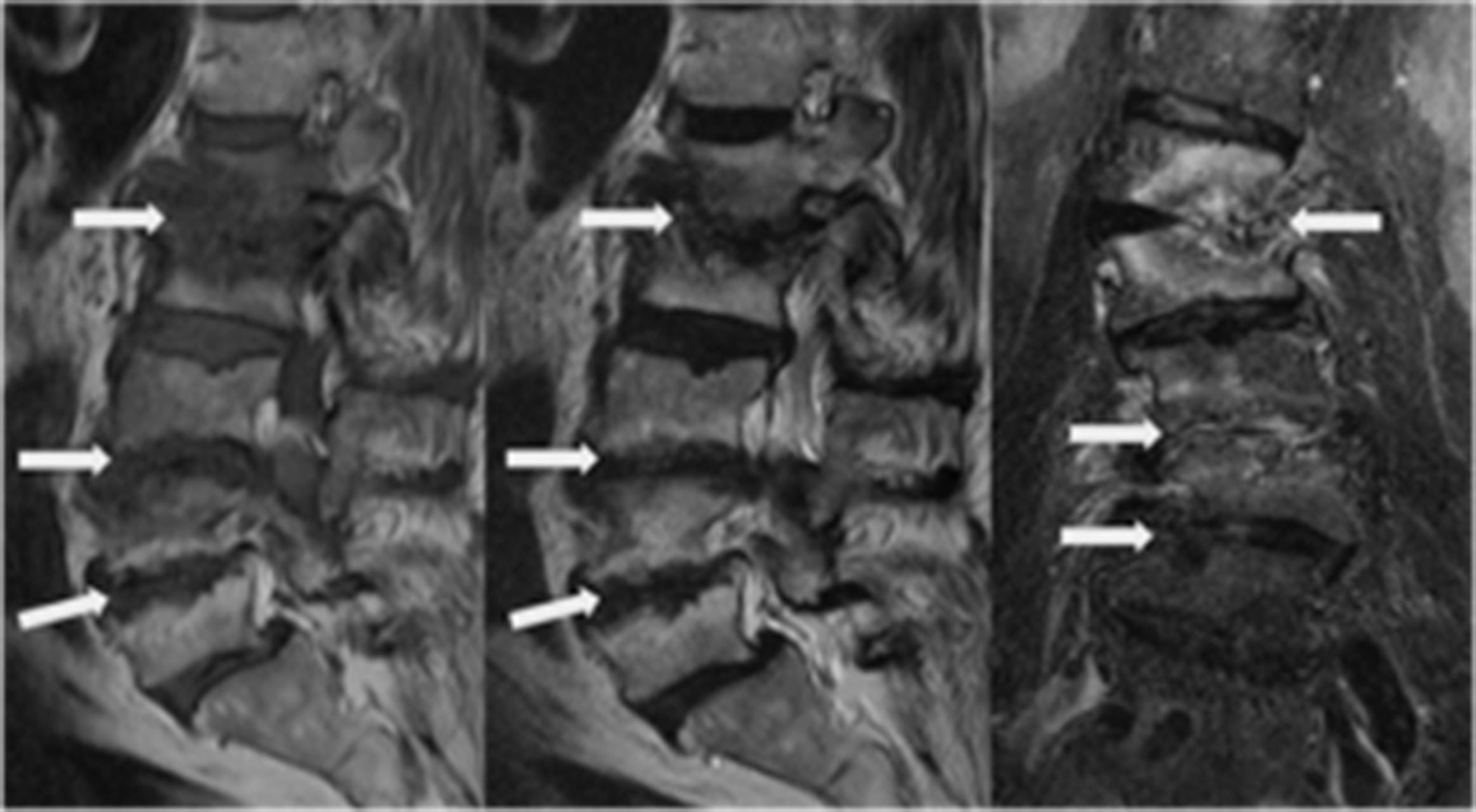
Increased shear stress in the lumbar structures and vertebrae is the result of structural changes leading to an altered mechanical environment in the disc [ , ] (see Chapter 8 ). Increased shear stress leads to minor fracture of the endplate [ ] and, as a consequence, enhances ascending inflammatory response from the disc into the vertebral bone marrow, leading to MC development [ ]. Indeed, MC1s have been found to demonstrate fissuring and disruption of the endplate [ , ]. Increased shear stress could also influence the shape of the endplate. Irregular endplates were associated with greater translational motion and higher prevalence of MCs compared to concave or flat endplates [ ]. In addition, longitudinal follow-up of surgical fusion studies gives an interesting insight into the role of instability and the effect of stabilization on MCs (see below Surgical options) ( Fig. 11.6 ) [ , ].
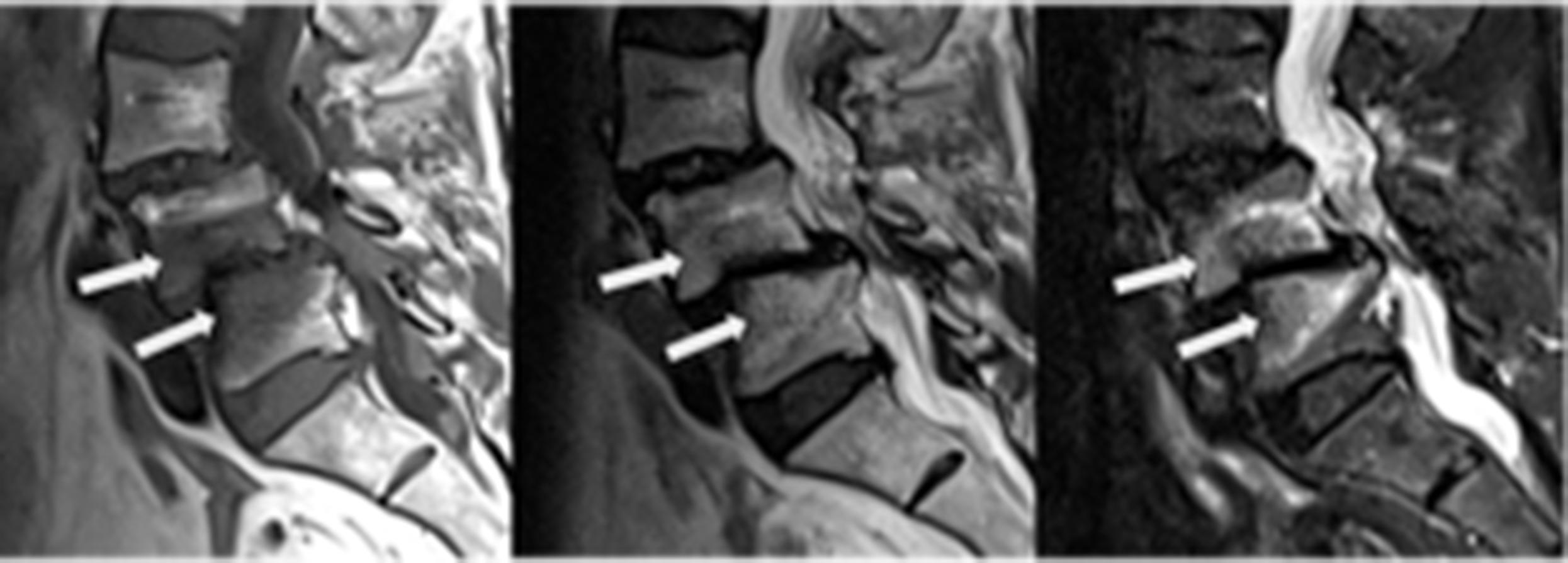
Become a Clinical Tree membership for Full access and enjoy Unlimited articles
If you are a member. Log in here